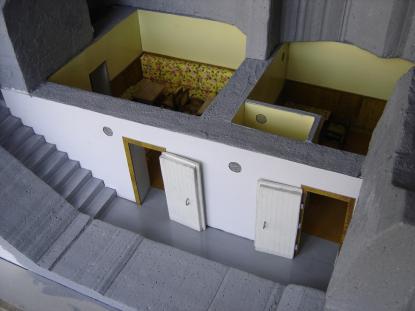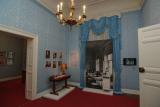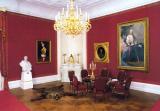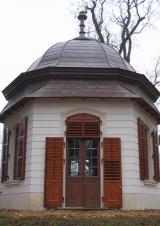2025. July 6. Sunday
Museum of the Royal Palace at Gödöllő - Gödöllő
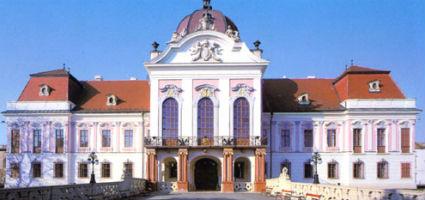 |
Address: 2100, Gödöllő Grassalkovich Kastély
Phone number: (28) 420-331, (28) 430-864
E-mail: informacio@kiralyikastely.hu
Opening hours: 02.01-28.02: Mon-Sun 10-17
01-31.03.: Mon-Fri 10-17, Sat-Sun 10-18 01.04-31.10.: Mon-Sun 10-18 02.11-31.12.: Mon-Fri 10-17, Sat-Sun 10-18 |
One of the most respected noblemen of the 18th century, Count Antal Grassalkovich I (1694-1771) started the construction works of the Gödöllő Palace in 1735. The first contstruction phase lasted until 1749. This was the time when the first U-shaped wing embracing the inner courtyard was completed based on András Mayerhoffer's plans, including the ornamental hall and the noble suites. Between 1746 and 1749 a new wing was added to each side of the building. In the southern wing a stable and a coal-holder attic were created, while in the northern wing a Roman Catholic church was built, which is still in operation today. It was in this state that Queen Maria Theresa saw the palace in 1751 when she visited Grassalkovich in Gödöllő.
The count then went on expanding and rebuilding the palace in a series of phases. In the double U-shaped building his son, Antal Grassalkovich II (1734-1794) constructed a Baroque stone theatre. During the time of his grandson, further construction work was carried out to build the last wing of the northern side, to build the new orange-house and to convert the French garden into a landscape garden The uniquely-created architecture of the palace served as an exemplary model for other Hungarian palaces of the Baroque period.
The death of Antal Grassalkovich III at the same time meant the end of the family's male line. The property, inherited on the female line, was purchased by Baron György Sina (1783-1856) in 1850 and was later sold to a Belgian bank by his son Simon Sina (1810-1876) in 1864. The second golden era of the construction began in 1867. Bought by the Hungarian state, and reconstructed, the palace - as a coronation gift - went into the use of Emperor Francis Joseph I (1830-1916) and Queen Elizabeth (1837-1898) as their resort place. The royal family spent the springs and autumns here, at Gödöllő. After the death of Queen Elizabeth (1898), the monarch visited the place less frequently: his last visit was in 1911.The sojourn of Charles IV (1887-1922), who followed Francis Joseph I on the throne, was ended by the collapse of the monarchy on 26 October, 1918. From 1920 on, there came a period, similar to that of the royal era, when the palace served as a summer resort for Governor Miklós Horthy (1868-1957), ended by the outbreak of the Second World War. Although the building itself was left undamaged, the German and Russian troops invading in 1944 carried away or destroyed most of the furnishings. From 1950 on, Soviet troops were stationed in the outbuildings, while the main building became a home for the aged. These abuses gradually led to the deterioration of the building complex. Conservation began in 1985, and some years later the building was emptied as a precondition of reconstruction.
The renewal and development of the palace is coordinated by the Gödöllő Royal Palace Company. As a final act of the first phase of the reconstruction works, in August 1996, the main wing was opened for the first permanent exhibition of the Museum: the ornamental hall and the royal apartments. These suites, arranged in the style of the age, are telling of the country under the Austro-Hungarian monarchy and of the personalities of Emperor Francis Joseph I and Queen Elizabeth alike.
As there is little that has remained from the furnishings at Gödöllő, the suites also display objects from ecclesiastical and public collections as well as personal belongings of the royal couple from elsewhere. In June 1997, further rooms were added to the royal suites, and one year later, upon the 100th anniversary of Elizabeth's death, the Queen Elizabeth memorial exhibition was inaugurated. On August 10, 2001, the 250th anniversary of Maria Theresa's visit to Gödöllő, the permanent exhibition of the Museum was completed with halls recalling the Grassalkovich and the Baroque era of the Palace. With a visit to the museum, you can also see the Baroque theatre, which was renovated in 2003, as well as the pavilion on Kinghill inaugurated in 2004. Furthermore, the seasonal exhibition rooms offer historical and contemporary arts exhibitions all year round.
The count then went on expanding and rebuilding the palace in a series of phases. In the double U-shaped building his son, Antal Grassalkovich II (1734-1794) constructed a Baroque stone theatre. During the time of his grandson, further construction work was carried out to build the last wing of the northern side, to build the new orange-house and to convert the French garden into a landscape garden The uniquely-created architecture of the palace served as an exemplary model for other Hungarian palaces of the Baroque period.
The death of Antal Grassalkovich III at the same time meant the end of the family's male line. The property, inherited on the female line, was purchased by Baron György Sina (1783-1856) in 1850 and was later sold to a Belgian bank by his son Simon Sina (1810-1876) in 1864. The second golden era of the construction began in 1867. Bought by the Hungarian state, and reconstructed, the palace - as a coronation gift - went into the use of Emperor Francis Joseph I (1830-1916) and Queen Elizabeth (1837-1898) as their resort place. The royal family spent the springs and autumns here, at Gödöllő. After the death of Queen Elizabeth (1898), the monarch visited the place less frequently: his last visit was in 1911.The sojourn of Charles IV (1887-1922), who followed Francis Joseph I on the throne, was ended by the collapse of the monarchy on 26 October, 1918. From 1920 on, there came a period, similar to that of the royal era, when the palace served as a summer resort for Governor Miklós Horthy (1868-1957), ended by the outbreak of the Second World War. Although the building itself was left undamaged, the German and Russian troops invading in 1944 carried away or destroyed most of the furnishings. From 1950 on, Soviet troops were stationed in the outbuildings, while the main building became a home for the aged. These abuses gradually led to the deterioration of the building complex. Conservation began in 1985, and some years later the building was emptied as a precondition of reconstruction.
The renewal and development of the palace is coordinated by the Gödöllő Royal Palace Company. As a final act of the first phase of the reconstruction works, in August 1996, the main wing was opened for the first permanent exhibition of the Museum: the ornamental hall and the royal apartments. These suites, arranged in the style of the age, are telling of the country under the Austro-Hungarian monarchy and of the personalities of Emperor Francis Joseph I and Queen Elizabeth alike.
As there is little that has remained from the furnishings at Gödöllő, the suites also display objects from ecclesiastical and public collections as well as personal belongings of the royal couple from elsewhere. In June 1997, further rooms were added to the royal suites, and one year later, upon the 100th anniversary of Elizabeth's death, the Queen Elizabeth memorial exhibition was inaugurated. On August 10, 2001, the 250th anniversary of Maria Theresa's visit to Gödöllő, the permanent exhibition of the Museum was completed with halls recalling the Grassalkovich and the Baroque era of the Palace. With a visit to the museum, you can also see the Baroque theatre, which was renovated in 2003, as well as the pavilion on Kinghill inaugurated in 2004. Furthermore, the seasonal exhibition rooms offer historical and contemporary arts exhibitions all year round.
